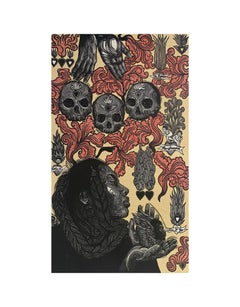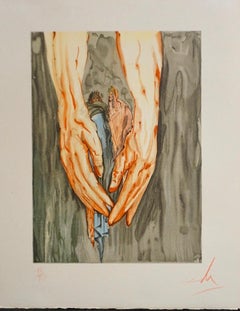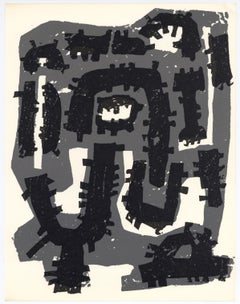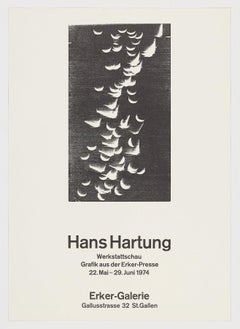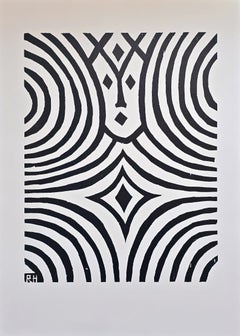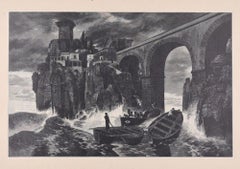Art by Medium: Woodcut
to
581
3,608
508
329
171
285
Overall Width
to
Overall Height
to
52
752
3,488
615
31
108
447
320
159
220
410
172
160
117
27
2,443
619
253
214
199
113
54
46
43
24
5
3
1
3,430
1,331
118
2,355
1,215
899
853
615
462
458
409
392
366
358
273
238
216
209
184
178
145
137
106
4,908
182,087
95,957
77,625
76,636
170
151
57
50
47
389
2,260
1,913
1,895
Medium: Woodcut
Serie Oratorios
Located in Toronto, ON
44" x 30" Unframed
3 Ink Woodcut Print on Paper
Hand Signed by Iván Bautista
Category
21st Century and Contemporary Art by Medium: Woodcut
Materials
Woodcut
Divine Comedy Hell Canto 31
Located in Hollywood, FL
ARTIST: Salvador Dali
TITLE: Divine Comedy Hell Canto 31
MEDIUM: Woodblock
SIGNED: Hand Signed
EDITION NUMBER: 18/150
MEASUREMENTS: 9" x 13.5"
CONDITIO...
Category
Mid-20th Century Surrealist Art by Medium: Woodcut
Materials
Woodcut
original woodcut
By Raoul Ubac
Located in Henderson, NV
Medium: original woodcut. This original Raoul Ubac woodcut was issued in 1958 for the hard-to-find XXe Siecle (No. 10), published in Paris by San Lazzaro. Sheet size 12 3/8 x 9 1/2 i...
Category
1950s Art by Medium: Woodcut
Materials
Woodcut
Hans Hartung 1974 Original Unused Vintage Poster Woodcut Erker Galerie German
By Hans Hartung
Located in Miami, FL
Hans Hartung (Germany, 1904-1989)
Erker-Galerie, 1974
Woodcut on paper
27.6 x 19.7 in. (70 x 50 cm.)
Excellent condition, unframed
Edition of 0
Ref: HAR100-203
Hans Hartung was born...
Category
1970s Abstract Art by Medium: Woodcut
Materials
Woodcut
Christus, 1961 (Expressionist, Spiritual Theme)
Located in Kansas City, MO
Richard Haizmann
Christus, 1961
Woodcut
Year: 1987 (printed)
Size: 33.66 x 24.01 inches (85.5 × 61 cm)
Stamped verso by the Estate, signed "Dr. Wolfgang Wesiack"
COA provided
*Will ...
Category
1960s Expressionist Art by Medium: Woodcut
Materials
Woodcut
Pirates attack the Castle on the Sea - Original Woodcut by J.J. Weber - 1898
Located in Roma, IT
Image dimensions: 23 x 35 cm.
Original Title: Von Piraten überfallene Burg am Meer
Pirates attack the Castle on the sea is a black and white xylograph on Japon applied on ivory-colored paper, after Arnold Böcklin...
Category
1890s Symbolist Art by Medium: Woodcut
Materials
Woodcut
Purgatory - Woodcut - 1963
Located in Roma, IT
Purgatory, Plate- 13 is a woodcut print realized in 1963 for a series illustrating the Medieval poem of the "Divine Comedy" by Dante Alighieri.
Not signed, as issued.
Good condi...
Category
1960s Surrealist Art by Medium: Woodcut
Materials
Woodcut
"Gespenstersonate" original woodcut
Located in Henderson, NV
Medium: original woodcut. Executed in 1920 for Das Kunstblatt, published in Berlin by Verlag Gustav Kiepenheuer. The total sheet measures 10 3/4 x 8 3/4 inches (275 x 210mm); the ima...
Category
1920s Expressionist Art by Medium: Woodcut
Materials
Woodcut
Crucifixion (Stabat Mater) - Original wooodcut, Handsigned & Numbered
Located in Paris, IDF
Louis JOU (1881-1968)
Crucifixion (Stabat Mater), 1924
Original woodcut
Handsigned in pencil
Numbered /125
On vellum 32.5 x 25.5 cm (c. 13 x 10 in)
Bears the blind stamp of the edit...
Category
1920s Modern Art by Medium: Woodcut
Materials
Woodcut
Kandinsky, Plate (folio 12), Société internationale d'art XXe siècle (after)
Located in Southampton, NY
Woodcut on vélin paper. Paper Size: 12.4 x 9.65 inches. Inscription: Signed in the block and unnumbered, as issued. Notes: From the album, XXe siècle Paris, Hommage à Wassily Kandins...
Category
1970s Modern Art by Medium: Woodcut
Materials
Woodcut
$716 Sale Price
20% Off
LOVERS (LIEBESPAAR
Located in Santa Monica, CA
ROBERT PHILIPPI (Austrian 1877-1959)
LIEBESPAAR (LOVERS) ca.1923 (in Rifkind Collection, LACMA: From a portfolio of 10 prints. Rifkind indicates the e...
Category
1920s Expressionist Art by Medium: Woodcut
Materials
Woodcut
Stevan Dohanos, Backyard
Located in New York, NY
Stevan Dohanos was an accomplished draftsman who work was widely known through the Saturday Evening Post. This print 'Backyard,' however, leaves aside the illustrative magazine work ...
Category
1930s American Modern Art by Medium: Woodcut
Materials
Woodcut
Cheval et âne en Provence, Vingt fables de La fontaine, Yves Brayer
By Yves Brayer
Located in Southampton, NY
Woodcut on vélin d'Arches paper. Inscription: signed in the plate and unnumbered, as issued. Good condition. Notes: from the folio, Vingt fables de La fontaine, 1961. Published by Éd...
Category
1960s Modern Art by Medium: Woodcut
Materials
Woodcut
$716 Sale Price
20% Off
Midnight Wolf: A Limited Edition Clarence Mills Signed Haida Inuit Print
Located in Alamo, CA
"Midnight Wolf" is a framed signed limited edition abstract inuit native people's work by Northwest Coast Haida artist Clarence Mills. The print depicts a st...
Category
Late 20th Century Abstract Art by Medium: Woodcut
Materials
Woodcut
"Femme nu" woodcut
Located in Henderson, NV
Medium: woodcut (engraved by Jacques Beltrand after Cezanne). This impression on cream laid paper was printed in 1914 and published by Bruno Cassirer and Theodore Duret. Image size: ...
Category
1910s Impressionist Art by Medium: Woodcut
Materials
Woodcut
At the Circus - Original wooodcut, Handsigned
Located in Paris, IDF
Robert BONFILS
At the Circus, 1927
Original woodcut
Handsigned in pencil
Numbered /160
On vellum 32.5 x 25.5 cm (c. 13 x 10 in)
Bears the blind stamp of the editor 'Imagier de la Gr...
Category
1920s Art Deco Art by Medium: Woodcut
Materials
Woodcut
Cannes : View from California Park - Original wooodcut, Handsigned
Located in Paris, IDF
Jules PERRICHON (1866-1946)
Cannes : View from California Park, 1928
Original woodcut
Handsigned in pencil
Numbered /160
On vellum 32.5 x 25.5 cm (c. 13 x 10 in)
Bears the blind sta...
Category
1920s Art Deco Art by Medium: Woodcut
Materials
Woodcut
David Shrigley - Pig Loves You - Edition of 30
Located in London, GB
David Shrigley
Pig Loves You, 2025
Woodcut
53 x 40 cm
Edition of 30
hand-signed and numbered by the artist
published by Shäfer Editions and comes with COA from the publishers
David ...
Category
2010s Contemporary Art by Medium: Woodcut
Materials
Woodcut
"Improvisation 7" original woodcut
Located in Henderson, NV
Medium: original woodcut. (Catalogue reference Roethel 124). Printed in 1975 on Arches paper for the "Homage to Kandinsky" special edition of the art revue XXe Siecle. Image size: 7 ...
Category
1970s Art by Medium: Woodcut
Materials
Woodcut
Motif aus Improvisation 25: The Garden of Love
Located in Henderson, NV
Medium: woodcut (after Kandinsky). Printed in 1959 for the art revue of XXe Siecle (issue number 13) and published in Paris by San Lazzaro. Image size: 8 1/2 x 8 3/4 inches (217 x 22...
Category
1950s Expressionist Art by Medium: Woodcut
Materials
Woodcut
"Coyote Scratching His Fleas..." - Woodblock Print
By Daniel Stolpe
Located in Soquel, CA
Vibrant print of a coyote by Daniel Stolpe (American, 1939-2018). Titled, numbered ("Presentation Proof"), signed and dated along bottom edge. Presented in a black frame with a double mat. Sheet on verso with information about the piece, stating that only 5 Presentation Proofs were created, making this piece 1 of 5. Paper size: 24"H x 28"W.
(2018) Master artist and Native Images lithographer Dan "Coyote" Stolpe slipped out of his non-functioning body, and is running free at last and howling in the hills. Born and raised in Los Angeles, Dan's father introduced him to Native American teachers of Art and Culture through the Woodcraft Rangers, who influenced Dan for the rest of his life. "Everything was patterned after a tribal structure," Stolpe said. We learned about Indian life and lore and we had Indian guys teach us how to make Indian costumes and about Indian dance and drums. That's what got me interested."
Dan made his first drum when he was 14, and he was quietly playing that same drum during his final days of life.
Stolpe attended LA Co. Art Institute (OTIS) on scholarship until 1962, when he dropped out to Apprentice with artist Don La Viere Turner in Glendora, and then with Master Printer Joe Funk in Venice until 1966. Commissioned by the Smithsonian Institute, he moved to Washington DC to illustrate extinct birds...
Category
1980s Contemporary Art by Medium: Woodcut
Materials
Ink, Rice Paper, Woodcut
$2,100 Sale Price
20% Off
Abstract with Figures Israeli Mid Century Modernist Woodcut Watercolor Painting
Located in Surfside, FL
An abstracted composition containing a kneeling figure . this is a stamped print, woodcblock most likely artfully combined with moody watercolor.
Stefan Alexander, born Czechoslovak...
Category
Mid-20th Century Art by Medium: Woodcut
Materials
Watercolor, Woodcut
Landscape - Woodcut by Monique Journod - Mid-20th Century
By Monique Journod
Located in Roma, IT
Landscape is a print realized by Monique Journod in the Mid-20th Century.
Signed on the plate
Woodcut on paper
Numbered. Edition, 30/200.
Good cond...
Category
Mid-20th Century Modern Art by Medium: Woodcut
Materials
Woodcut
Yamabe-no-Akahito / One Hundred Poems by One Hundred Poets 百人一首絵抄
Located in BRUCE, ACT
Toyokuni-III (1786-1864)
Title: Yamabe-no-Akahito 山部赤人
From Series: One Hundred Poems by One Hundred Poets 百人一首絵抄
Size: O-ban 大判
Age: 1843-47
FREE SHIPPING
Category
1840s Art by Medium: Woodcut
Materials
Woodcut
Violets
Located in Surfside, FL
Born in Budapest in 1907, he had a humble upbringing and a passion for the arts. Shortly after the Hungarian Revolution broke out in 1956, Domján was invited to showcase his work in New York; given both the circumstances and opportunities, he readily accepted. Eventually, with his wife and children, he settled in Tuxedo Park. Here, he established the Domján Studio and where lived until his passing in 1992. In his early years, and during the Great Depression, Domján toured Europe with the desire to be engulfed by art. Previously, much of his time had been consumed with the work of both an engine fitter and foundry worker. After testing the waters of over 20 different professions, he discovered his passion in the arts. Later, during his European tour, he earned his way by selling a variety of works including both paintings and sketches. Post-depression, he returned to Hungry where he studied seven years at the Budapest Academy of Arts.
Having spent an earlier portion of his life as a painter, Domján created his first woodcut in 1947 by using oil paint as opposed to printer’s ink. The result was stunning. This technique, becoming his signature style, would later set him apart from others within the trade. To create his pieces, Domján applied rich color, layer by layer, and lays claim to having “succeeded in bringing to the world something that had not existed before.”
Ultimately, each print became three dimensional and gave the appearance of a painting. His technique has gained him international merit as well as the honor of receiving China’s “Master of the Color Wooodcut” award, a recognition given only once every century. The inspiration behind many of Domján’s woodcuts, coupled with his love of nature, is derived from Hungary’s brilliant folklore. The intricacy of his design is certainly his prominent element; however, their subtle coloring and abstract images contribute to his
unique style.
For the 59th Anniversary of composer Béla Bartók’s opera, Duke Bluebeard’s Castle, Domján used the opera’s profound imagery to create a series of woodcuts. The work included an ominous castle, coiled snakes, smirking masks, elusive zodiac symbols, and the story’s forbidden key. In doing so, Domján was able to weave traditional folklore components into a fantastic piece of modernized art. His work is not only expressive of Hungarian folklore...
Category
20th Century Art by Medium: Woodcut
Materials
Wood, Mixed Media, Woodcut
Hercule Gaulois, ou L’Éloquence
By Charles-Nicolas II Cochin
Located in Middletown, NY
A classical chiaroscuro woodcut after Raphael executed by Charles Nicolas Cochin Père (1688-1754) & Vincent Le Sueur (1668-1743) . Printed from two bloc...
Category
Early 18th Century Old Masters Art by Medium: Woodcut
Materials
Laid Paper, Woodcut
"Kopf" original woodcut
Located in Henderson, NV
Medium: original woodcut. This bold and striking Expressionist woodcut was printed in 1920 for Genius. Image size: 9 1/2 x 7 inches (240 x 180 mm). This original Rouveyre print is fr...
Category
1920s Expressionist Art by Medium: Woodcut
Materials
Woodcut
KOPF (Head)
By Max Kaus
Located in Santa Monica, CA
MAX KAUS (German 1891-1977)
KOPF (Head( (Rifkind 1387)
Woodcut, unsigned, monogram in block. As issued as plate 1 from “Genius” Zeitschrift für werdende und alte Kunst, vol. 2, no. ...
Category
1920s Expressionist Art by Medium: Woodcut
Materials
Woodcut
EARLY MORNING (BROAD BROOK, CONN.)
By Asa Cheffetz
Located in Portland, ME
Cheffetz, Asa EARLY MORNING (BROAD BROOK, CONN.) Wood Engraving,1929. Springfield 15. Edition of 100, numbered 32/100, titled, signed, and inscribed "imp" all in pencil. 6 x 6 inches...
Category
1920s Art by Medium: Woodcut
Materials
ABS, Woodcut
"Self Portrait" original woodcut
Located in Henderson, NV
Medium: original woodcut. Printed in 1920 for the Deutsche Graphiker der Gegenwart portfolio, and published in Leipzig by Klinkhardt & Biermann in an edition of 500. Catalogue refere...
Category
1910s Expressionist Art by Medium: Woodcut
Materials
Woodcut
Picasso, Sans titre (J/Vollard 193; Monod 10485), Hélène chez Archimède (after)
Located in Southampton, NY
Woodcut on vélin de Montval-Maillol paper. Paper Size: 17.3 x 12.6 inches; image size: 10.6 x 7.9 inches. Inscription: Unsigned and unnumbered, as issued. Catalogue raisonné referenc...
Category
1950s Cubist Art by Medium: Woodcut
Materials
Woodcut
$1,116 Sale Price
20% Off
Gauguin, Change of Residence (Changement de résidence), Gauguin (after)
By Paul Gauguin
Located in Southampton, NY
Woodcut on vélin Utopian paper. Unsigned and unnumbered, as issued. Good Condition. Notes: From the folio, Gauguin, A portfolio of 12 color woodblocks, Paul Gauguin, French, 1848-1903 from the collection of the Museum Of Fine Arts, Boston, 1946. Rendered by Albert Carman (1899-1949); published the Museum Of Fine Arts, Boston and The Studio Publications, Inc., New York and London; printed by Holme Press Inc., New York, in an edition of MMMD. Excerpted from the folio, Paul Gauguin and Emil Bernard at Pont-Aven, Brittany, in 1888, each made a bas-relief, wooden panel to decorate a piece of furniture for a friend. In order to keep a record of their designs, a few inked impressions were made on paper. The illustration at left is a reproduction of a print which is possibly one of the above mentioned. It is further possible that this experiment later gave Gauguin the idea of making woodcuts. Just as his work in painting expressed a revolt against the overemphasis on factual representation of the nineteenth century in favor of decorative pattern and color, so also his woodcuts leaned strongly to the same side of the balance. Ten of the cuts reproduced (all excepting Soyez Amoureuses and Changement de Residence), which constitute the whole of his best known series, were made at Pont-Aven beginning in the fall of 1894, after Gauguin's return from his first trip to Tahiti and after he broke his ankle. They were at first roughly cut with a common carpenter's gouge, and the flat surfaces sandpapered and engraved with a sharp in-strument, perhaps an engraver's burin. A few trial proofs were printed in black ink only. Then the hollows were deepened with a woodcutter's gouge and highlights were added. An edition of thirty to fifty impressions of each subject, with the addition of color blocks (one, two or three), was made by Louis Roy...
Category
1940s Post-Impressionist Art by Medium: Woodcut
Materials
Woodcut
$716 Sale Price
20% Off
Horses - Woodcut Print - 1962
Located in Roma, IT
Horses is an original woodcut print on paper realized in 1962 by an Anonymous artist of the 20th Century.
Hand-signed on the lower right and dated, ill...
Category
1960s Contemporary Art by Medium: Woodcut
Materials
Woodcut
'Bullfight'— Mid-century American Surrealism
Located in Myrtle Beach, SC
Robert Vale Faro, 'Bullfight', wood engraving, 1945, edition 15. Signed, dated, titled, and numbered '105' (the artist's inventory number) and '13/15' in pencil. A fine, richly-inked impression, on cream wove paper, with full margins (1 1/16 to 2 3/8 inches), in excellent condition. Scarce. Matted to museum standards, unframed.
Image size 5 1/16 x 4 1/16 inches (129 x 103 mm); sheet size 8 9/16 x 6 5/16 inches (217 x 160 mm).
An impression of this work is included in the museum collection of the National Gallery of Art.
ABOUT THE ARTIST
Robert Vale Faro (1902-1988) was a well-known modernist architect and artist associated with the Chicago Bauhaus. He received his degree in architecture and design from the Armour Institute in Chicago and worked at L'Ecole des Beaux-Arts, Paris, from 1924-27, where he was influenced by Harry Kurt Bieg and Le Corbusier. Upon his return to Chicago, Faro worked with the important modernist Chicago architects George and William Keck under Louis Sullivan.
Faro founded the avant-garde printmaking group Vanguard in 1945. The group counted Atelier 17 artists Stanley William Hayter, Sue Fuller, and Anne Ryan as New York members and Francine Felsenthal...
Category
1940s Surrealist Art by Medium: Woodcut
Materials
Woodcut
$360 Sale Price
20% Off
"Coriolan und seine Mutter" signed original woodcut
Located in Henderson, NV
Medium: original woodcut. Signed in pencil by Peter Trumm and printed in Germany in 1922 for the very rare "Die zweite Ganymed-Mappe" portfolio of "Das vierte Jahrbuch der Marees Ges...
Category
1920s Expressionist Art by Medium: Woodcut
Materials
Woodcut
Spanish Woman - Original wooodcut, Handsigned & Numbered
Located in Paris, IDF
Louis JOU (1881-1968)
Spanish Woman, 1929
Original woodcut
Handsigned in pencil
Numbered /125
On vellum 32.5 x 25.5 cm (c. 13 x 10 in)
Bears the blind stamp of the editor 'Imagier d...
Category
1920s Modern Art by Medium: Woodcut
Materials
Woodcut
Allegory of Peace : the Family in Countryside - Original wooodcut, Handsigned
By Paul Colin
Located in Paris, IDF
Paul Emile Colin
Allegory of Peace : the Family in Countryside, 1929
Original woodcut
Handsigned in pencil
Numbered /160
On vellum 32.5 x 25.5 cm (c. 13 x 10 in)
Bears the blind sta...
Category
1920s Art Deco Art by Medium: Woodcut
Materials
Woodcut
Art Deco Landscape : The Bridge in Brittain - Original wooodcut, Handsigned
Located in Paris, IDF
Alfred LATOUR (1888-1964)
Art Deco Landscape : The Bridge in Brittain, 1928
Original woodcut
Handsigned in pencil
Numbered /160
On vellum 32.5 x 25.5 cm (c. 13 x 10 in)
Bears the bl...
Category
1920s Art Deco Art by Medium: Woodcut
Materials
Woodcut
Birds in a Nest - Woodblock Print on Paper #3/6
Located in Soquel, CA
Birds in a Nest - Woodblock Print on Paper #3/6
Black and white woodblock by Janet Wheeler (American, 1922-2001). Four birds are shown in a nest, along with a cracked eggshell. The birds and the nest are depicted in a bold, stylized manner, with clever use of negative space.
Numbered "3/6" at bottom center.
Signed "Janet P Wheeler...
Category
Mid-20th Century American Modern Art by Medium: Woodcut
Materials
Paper, Ink, Woodcut
$640 Sale Price
20% Off
Picasso, Sans titre (J/Vollard 193; Monod 10485), Hélène chez Archimède (after)
Located in Southampton, NY
Woodcut on vélin de Montval-Maillol paper. Paper Size: 17.3 x 12.6 inches; image size: 10.4 x 8.7 inches. Inscription: Unsigned and unnumbered, as issued. Catalogue raisonné referenc...
Category
1950s Cubist Art by Medium: Woodcut
Materials
Woodcut
$1,116 Sale Price
20% Off
"Cormorant and Egret" Japanese Woodblock Print of Birds in Water & Nature Poem
Located in Austin, TX
Artist: Kitagawa Utamaro the First (Japanese, 1753 - 1806)
Publisher: Tsutaya Jūzaburō (Japanese, 1750 - 1797)
Page Size: 10 x 15 in.
Frame Size: 16 x 22 in.
An Edo Period color woo...
Category
1790s Art by Medium: Woodcut
Materials
Paper, Woodcut
Jockey Before the Horse Race - Original wooodcut, Handsigned & numbered /160
Located in Paris, IDF
Pierre LISSAC (1878-1955)
Jockey Before the Horse Race, 1926
Original woodcut
Handsigned in pencil
Numbered /160
On vellum 32.5 x 25.5 cm (c. 13 x 10 in)
Bears the blind stamp of th...
Category
1920s Modern Art by Medium: Woodcut
Materials
Woodcut
Shepherdess and her Sheep - Original wooodcut, Handsigned & Numbered
Located in Paris, IDF
Henri AMEDEE-WETTER (1869-1929)
Shepherdess and her Sheep, 1920
Original woodcut
Handsigned in pencil
Numbered /105
On vellum 32.5 x 25.5 cm (c. 13 x 10 in)
Bears the blind stamp of...
Category
1920s Modern Art by Medium: Woodcut
Materials
Woodcut
Italy : In a Small Street of Procida - Original wooodcut, Handsigned
By Paul Colin
Located in Paris, IDF
Paul Emile Colin
Italy : In a Small Street of Procida, 1922
Original woodcut
Handsigned in pencil
Numbered /154
On vellum 32.5 x 25.5 cm (c. 13 x 10 in)
Bears the blind stamp of the...
Category
1920s Art Deco Art by Medium: Woodcut
Materials
Woodcut
The Pilgrimage Procession to Kinryuzan Temple at Asakusa in the Eastern Capital
By Kuniyasu
Located in Soquel, CA
Japanese Parade - Woodblock Print
Japanese woodblock print by Utagawa Kuniyasu (歌川 国安) (Japan, 1794–1832). Japanese women, dressed in blue and red kimonos, are the focal point. A vi...
Category
Mid-19th Century Edo Art by Medium: Woodcut
Materials
Paper, Ink, Woodcut
Paris : Rainy Day - Original wooodcut, Handsigned and numbered / 160
Located in Paris, IDF
Jean LOMBARD (1895-1983)
Paris : Rainy Day, 1925
Original woodcut
Handsigned in pencil
Numbered /160
On vellum 32.5 x 25.5 cm (c. 13 x 10 in)
Bears the b...
Category
1920s Modern Art by Medium: Woodcut
Materials
Woodcut
Bad Romance : The Duel - Original wooodcut, Handsigned & numbered /160
Located in Paris, IDF
Maximilien VOX (1894-1974)
Bad Romance : The Duel, 1925
Original woodcut
Handsigned in pencil
Numbered /160
On vellum 32.5 x 25.5 cm (c. 13 x 10 in)
Bears the blind stamp of the edi...
Category
1920s Modern Art by Medium: Woodcut
Materials
Woodcut
Naval Combat : the Sailboats - Original wooodcut, Handsigned and numbered / 160
Located in Paris, IDF
Daniel GIRARD
Naval Combat : the Sailboats, 1925
Original woodcut
Handsigned in pencil
Numbered /160
On vellum 32.5 x 25.5 cm (c. 13 x 10 in)
Bears the blind stamp of the editor 'Im...
Category
1920s Modern Art by Medium: Woodcut
Materials
Woodcut
CALLED BY SAKE (C.70)
By Jim Dine
Located in Aventura, FL
Woodcut, collagraph and photo-engraving in colors, on Rives Lightweight Cream paper, with full margins. Hand signed, dated and numbered lower front by Jim Dine. From the edition of...
Category
1990s Pop Art Art by Medium: Woodcut
Materials
Paper, Engraving, Woodcut
$7,960 Sale Price
20% Off
The Blind of Envy - Woodcut - 1963
Located in Roma, IT
The Blind of Envy is a woodcut print realized in 1963 for a series illustrating the Medieval poem of the "Divine Comedy" by Dante Alighieri.
Not signed, as issued.
Plate n.14 (as...
Category
1960s Surrealist Art by Medium: Woodcut
Materials
Woodcut
The Yarn
By John Buck
Located in Lyons, CO
Color woodcut/relief, Edition 15
Using a pen, a nail or his fingernail, Buck incises the wood planks that form the base and background of his prints with images and symbols drawn ...
Category
21st Century and Contemporary Contemporary Art by Medium: Woodcut
Materials
Woodcut
$4,500
Hasui Kawase NIGHT FISHING AT ITAKO Woodcut Print
Located in Lake Worth Beach, FL
Artist/Designer; Manufacturer: Hasui Kawase (Japanese, 1883-1957)
Marking(s); notes: artist's seal; circa 1935
Materials: woodcut
Dimensions (H, W, D): 5.5"h, 3.5"w; 12.75"h, 9.75"w...
Category
20th Century Modern Art by Medium: Woodcut
Materials
Woodcut
Depositare Vibrazioni 1 - Woodcut by Tommaso Cascella - 1990s
Located in Roma, IT
Engraving with wood carving matrix on paper 310 gr/m2, paper-work size 130cm x 49cm. Excellent condition, no defects.
Grafica Lombardi guarantee stamp.
Tommaso Cascella was born in...
Category
20th Century Contemporary Art by Medium: Woodcut
Materials
Woodcut
Fishing Boats in Cap Muroto
Located in San Francisco, CA
This artwork Titled "Fishing Boats in Cap Muroto" c.1950, is an original woodcut on paper by Japanese artist Gihachiro Okuyama, 1907-1981. It is hand signed and inscribed in Japanese...
Category
Mid-20th Century Modern Art by Medium: Woodcut
Materials
Woodcut
1870 View of Proposed Brooklyn Bridge and New York City
Located in Alamo, CA
This framed engraving entitled "Birds-eye View of the Southern End of New York and Brooklyn, Showing the Projected Suspension-Bridge Over the East River, From the Western Terminus in Printing-House Square, New York" by Theodore R. Davis (1840–1894) was published as a supplement of Harper's Weekly, November 19, 1870.
The print is presented in a maple frame and a double mat. The frame measures 23.5" high, 29" wide and 0.75" deep. There is a vertical center fold and additional vertical lines, where wood engraving blocks were joined for the printing process. It is in excellent condition.
This framed image depicting New York in 1870 was a centerfold for the November 19, 1870 issue of Harper's Weekly. It includes the site and eventual appearance of the East River New York-Brooklyn Bridge; the name later shortened to the Brooklyn Bridge. The print was issued eleven months after the start of construction of the bridge on January 2, 1870, which would take another 12.5 years to complete. When this view was drawn, work on the bridge was all below ground, constructing the supports for the bridge’s towers. Labels in the upper portion of the print identify locations in the background including "Light Ship...
Category
Late 19th Century Naturalistic Art by Medium: Woodcut
Materials
Woodcut
Utagawa Kuniyoshi -- No. 38 Totomi 遠江
Located in BRUCE, ACT
Utagawa Kuniyoshi
No. 38 Totomi 遠江, 1852
From Series: Sankai medetai zue 山海目出度図絵 (Celebrated Treasures of Mountains and Seas)
Woodblock print
Oban
Woodblock print, oban tate-e. Woma...
Category
1850s Art by Medium: Woodcut
Materials
Woodcut
"High and Low III" Abstract Patterns, Geometric Abstraction, Woodcut Monoprint
Located in Philadelphia, PA
This piece titled "High and Low III" is an original piece by Alexis Nutini and is made from a woodcut monoprint mounted on panel. This piece measures 9.5"h x 14.5"w.
Born in Mexico...
Category
21st Century and Contemporary Contemporary Art by Medium: Woodcut
Materials
Found Objects, Panel, Monoprint, Woodcut
Composition, Così fan tutte, Balthus
Located in Southampton, NY
Woodcut in colors on vélin paper. Paper Size: 19 x 18 inches. Inscription: Unsigned and unnumbered, as issued. Notes: From the album, Così fan tutte. Dramma giocoso in due atti. Musi...
Category
Early 2000s Modern Art by Medium: Woodcut
Materials
Woodcut
$1,996 Sale Price
20% Off
Hercules and Athena
Located in New Orleans, LA
edition 1/5
BARBARA KUEBEL is a Daphne, AL-based artist who uses oil and pencil for her works on paper and on canvas. She was born and raised in Austria and earned two art degrees f...
Category
21st Century and Contemporary Contemporary Art by Medium: Woodcut
Materials
Paper, Woodcut
Subterranean, Conceptual Woodblock Print by Genichiro Inokuma
Located in Long Island City, NY
Genichiro Inokuma, Japanese (1902 - 1993) - Subterranean, Year: 1970, Medium: Woodblock, signed and numbered in pencil, Edition: EA, Size: 6.5 x ...
Category
1970s Conceptual Art by Medium: Woodcut
Materials
Woodcut
Woodcut art for sale on 1stDibs.
Find a wide variety of authentic Woodcut art available on 1stDibs. While artists have worked in this medium across a range of time periods, art made with this material during the 21st Century is especially popular. If you’re looking to add art created with this material to introduce a provocative pop of color and texture to an otherwise neutral space in your home, the works available on 1stDibs include elements of orange, yellow, purple, blue and other colors. There are many well-known artists whose body of work includes ceramic sculptures. Popular artists on 1stDibs associated with pieces like this include Mino Maccari, Utagawa Kunisada (Toyokuni III), Eric Gill, and Utagawa Hiroshige. Frequently made by artists working in the Modern, Contemporary, all of these pieces for sale are unique and many will draw the attention of guests in your home. Not every interior allows for large Woodcut art, so small editions measuring 0.04 inches across are also available
Recently Viewed
View AllMore Ways To Browse
German Propaganda Poster
George And Martha
Golfers Watercolor
Glasgow Girls
Globe Watch
Golf Watercolor Art
Gold Whistle
George Edwards Engravings
George Allan Art
Hamer Vintage
Miniature Portrait Of A Lady
Golf Course Prints
Goddess Dior
Gorilla Sculpture
Ghost Watch
George Edwards Bird Prints
Gouache Naples
G Wright Art
